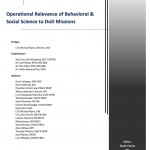Relevance of Behavioral and Social Science to DoD

Operational Relevance of Behavioral & Social Science to DoD Missions.
Author | Editor: Canna, S. (NSI, Inc).
This paper emerged from the “A World in Transformation: Challenges and Opportunities” Strategic Multi-layer Assessment (SMA) Conference in November 2012.2 Leaders from across the USG addressed the emerging challenges of the 21st century for defense analysts, planners, and operators. The first decade of the 21st century has ushered in a period of rapid change across the globe: demographic upheavals are challenging the status quo, classic nation states are in decline, and people are more interconnected than ever. Panelists agreed that in this uncertain environment, the social sciences3 play an ever-expanding role. Thought leaders from across the defense community discuss the relevance of social science to DoD operations in this section.
Building Frameworks to Inform Whole of Government Response
Maj. Gen. John “Jack” Shanahan, Deputy Director for Global Operations, Operations Directorate, Joint Staff
A paradigm shift is occurring across the globe. We do not yet know how the world will look when this shift is completed, though it is already being characterized within the Interagency as the “new normal.” We must consider two paradigms. First, adversaries and potential adversaries—often grouped under the rubric of Violent Extremist Organizations, or VEOs,– are becoming syndicated in ways we did not fully anticipate or appreciate a decade ago. We are witnessing a rising trajectory of communication, collaboration, and sharing of ideas, weapons, lessons learned, and tactics among disparate VEOs that once seemed to have very few common interests or goals—or even if they did, they were unable to join forces in ways that represented a more significant threat than they did in isolation. VEO cooperation, coordination, and synchronization are enabled by the explosion of social media and almost- instant global communications. At the same time, we are not keeping up with this VEO paradigm shift; when we do, it is often in a predominantly tactical and reactive manner. In short, our adversaries and potential adversaries are more rapidly and effectively shifting paradigms than we are.
There is an unmistakable ideological component to this paradigm shift. We are in danger of losing the strategic narrative, the so-called ‘battle for ideas.’ Our adversaries and potential adversaries are engaged as never before in a competition for the ideological high ground. Distorted ideas and ideals that were easily brushed aside twenty years ago are finding an unprecedented audience and gaining a dangerous foothold in the ungoverned spaces of the science can and must play a central role in both understanding and competing against the VEO ideology. In today’s information environment, the Internet and social media are among the most potent weapons in the VEO arsenal. We must engage readily and continuously in this electronic battlespace or we will lose the clash of ideas.
Federal agencies are working to respond to a broad spectrum of complex social threats facing the United States in the 21st century including radicalization, cyber radicalization, instability, and insurgency, but there is no uniformity of approach. The social sciences can provide a rigorous framework to explain these phenomena and to guide research, analysis, and operations. Social science knowledge, methodologies, and models inform the commanders so that conflict stays left of boom. However, further research is needed and operators need to better understand the role and potential of social science to inform decision-making and to ensure our paradigm shift is as substantial and as enduring as that of the VEOs.
Responding to Emerging Threats
Mr. Earl Wyatt, Deputy Assistant Secretary of Defense, Rapid Fielding in the Office of the Assistant Secretary of Defense for Research & Engineering
One of the Rapid Fielding Directorate’s (RFD) missions is to respond to emerging threats by identifying, developing, demonstrating, assessing, and rapidly fielding innovative concepts and technologies to meet operational needs. The social sciences are uniquely positioned to contribute knowledge, tools, and models to address some of the most pressing questions facing operators and decision makers today including:
- How do we best anticipate and disrupt the triggers of violent actions?
- How do we prepare for the unintended consequences that may result from U.S. engagement?
- How do we communicate U.S. intentions and foster trust in a country with decentralized government?
- How can we defuse the need for kinetic engagement and measure the success of these efforts?
- How do we best strengthen and measure the benefits of building partner capacity?
To address these questions, we need social science models capable of scaling up or down to address a wide range of divergent threats. This is critical to establishing a leaner, more agile force to effectively operate across all domains. It is imperative that the delivery of these technical capabilities is accelerated to win the current fight.
Multidisciplinary Responses to Complex Challenges
Mr. Ben Riley, Principal Deputy, Deputy Assistant Secretary of Defense for Rapid Fielding in the Office of the Assistant Secretary of Defense, Research and Engineering
Threats in the 21st century are increasingly complex and require multiple perspectives and disciplines to understand and anticipate challenges. No longer can the DoD rely solely on subject matter experts to understand and engage with populations. The social sciences need to be deployed at the tactical level. Social science insights, theories, and models give the commander the kind of information that is critical for him to achieve his mission in complex environments. However, it is not enough to employ social science tools and methods in the operational environment. The tools require the intellectual curiosity of the commander in the fields. The community needs to concurrently invest in training officers how to employ social science tools and methods.
The Changing Role of Social Sciences in the DoD
Dr. Robie Samanta Roy, Professional Staff Member, Senate Armed Services Committee
The changing nature of warfare emphasizes the need to develop a deeper understanding of the human perspective. Conflict is emerging in diverse corners of the world, and the DoD needs to develop the expertise in each of these regions. Social science initiatives are crucial for understanding this human terrain.
However, investment in the social sciences faces a few obstacles. First, the gap between the research and user communities needs to be bridged and narrowed. Second, coordination within the research community needs to be improved to eliminate redundancy, focus on meeting warfighter needs, and quickly transition from basic to applied research. Third, the emphasis on multidisciplinary approaches must be maintained and further developed including bringing together experts from across a broad spectrum of disciplines. Fourth, the community needs to do a better job of developing measures of effectiveness (MOE) to understand the impact of operations on communities of interest. Finally, the community needs to address the verification and validation of high quality data, models, and theories.
It is necessary to shape the future direction of social science programs now. This shaping will include the training of future experts to ensure that these efforts are sustainable. Additionally, through increases in international cooperation, greater insight on “the other” will be gained. Furthermore, research into the role of political and religious ideologies needs to be pursued. Finally, the convergence of behavioral science and neurobiology will help inform future challenges including how best to respond to adversaries that do not have the same ethical constraints that the U.S. does.
Contributing Authors
Maj. Gen. John Shanahan (JS/J-3/DDGO), Mr. Earl Wyatt (RFD/ASD R&E), Mr. Ben Riley (RFD/ASD R&E), Dr. Robie Samanta Roy (SASC), Hriar Cabayan (SMA OSD), David Adesnik (IDA), Chandler Armstrong (USACE ERDC), Allison Astorino-Courtois (NSI), Lt Col Alexander Barelka (USAF AFMC), Thomas Bozada (USACE ERDC), David Browne (PACOM), Charles Ehlschlaeger (USACE ERDC), Dana Eyre (SoSa), LTG Michael Flynn (DIA), LTC John Ferrell (SOUTHCOM), LeAnne Howard (SOCOM J5), Robert Jones (SOCOM J5), David Krooks (USACE ERDC), Anne McGee (NPS), Timothy Perkins (USACE ERDC), Dan Plafcan (OUSDI), Lucy Whalley (USACE ERDC)

Comments